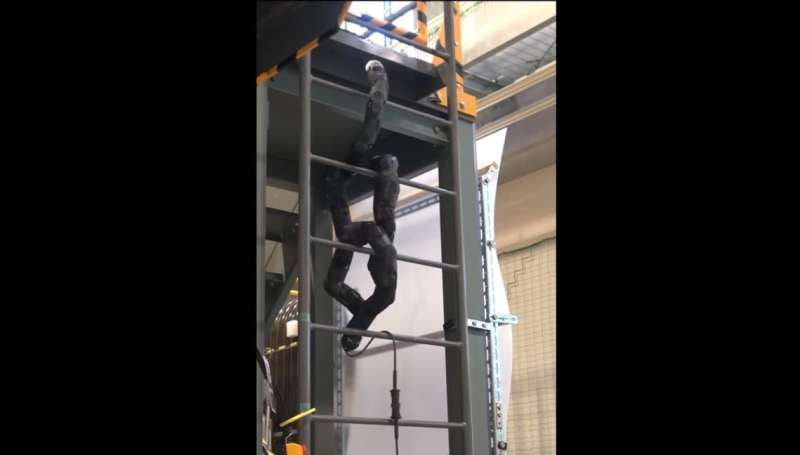October 16, 2018 weblog
An advanced snake-robot for disaster sites climbs by coiling

"Ladder Climbing with the Snake Robot" is a video that was released last year by Kyoto University's Matsuno Lab, and it is still drawing stares and shivers. Comments on the video have included "Thanks, I hate it."
Popular Mechanics in its headline advised readers that "You can't unsee" it scaling a ladder. Stephanie Mlot in Geek.com described a "slithering cyborg." She noted how "a plasticized serpent noisily wraps itself around each rung, swiftly ascending then descending."
The snake-like robot was shown at IROS in Madrid earlier this month. The team is from Kyoto University and the University of Electro-Communications.
The snake is able to climb ladders that are both inclined and fully vertical, said Future Timeline.
The team behind the robot snake have called attention to a "novel" gait. They said their design method configured the robot form "by connecting simple shapes." They said the climbing motion was executed "via shift control and the corresponding motion required to catch the next step on the ladder."
Diving deep into the robot design, Nkkei Asian Review noted that the device can make its way seamlessly up or down a ladder by altering body shape. "The joints have a 180-degree range of movement, allowing the robot to easily change its shape, while the smooth surface with few protrusions makes it less prone to getting stuck on obstacles."
It has 36 joints, equipped with angle sensors that can gauge the shape of the body, said Nikkei Asian Review. The shapes "securely wrap around each rung as it climbs upwards," said Future Timeline. Sam Blum in Popular Mechanics said, "The machine appears to writhe as it scales the ladder." On flat surfaces, said the Nikkei report, "the robot wiggles its way along in much the same way as a real snake."
The team used a 3D printer for the frame; system components included a PC, gamepad and power supply. "The device is controlled remotely by an operator who can see images from a camera mounted on the tip," said Nikkei Asian Review. "Each joint does not need to be manipulated individually; the operator merely has to input which way the robot should proceed after selecting the appropriate shape."
The motivation to develop the robot snake was not to scare people. Rather, the team focused on search and rescue, said Mlot, and disaster recovery; the robot snake can make its way in small spaces and rough terrain.
Nikkei Asian Review made it clear that the end goal was just that. The report said it could be used "for the inspection of collapsed buildings, according to Fumitoshi Matsuno, the robotics professor at Kyoto University leading the project."
What's next? The team "aims to put the device into practical use within two to three years," said Nikkei Asian Review.
"Matsuno was also involved in the development of the previous version," the report added, " which was designed for use in decommissioning the crippled Fukushima Dai-ichi nuclear power plant."
More information: www.mechatronics.me.kyoto-u.ac.jp/
© 2018 Tech Xplore





















